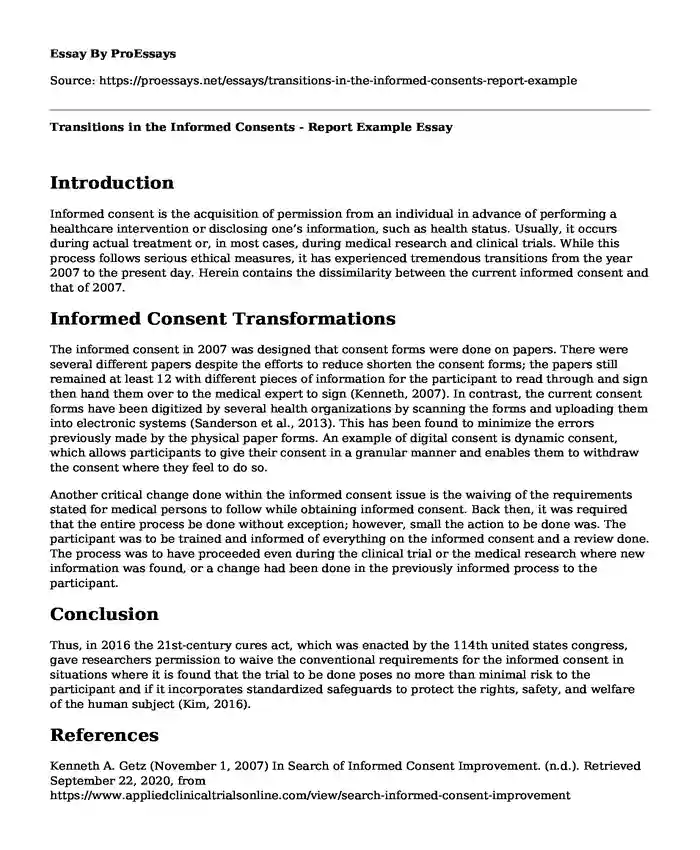Introduction
Informed consent is the acquisition of permission from an individual in advance of performing a healthcare intervention or disclosing one’s information, such as health status. Usually, it occurs during actual treatment or, in most cases, during medical research and clinical trials. While this process follows serious ethical measures, it has experienced tremendous transitions from the year 2007 to the present day. Herein contains the dissimilarity between the current informed consent and that of 2007.
Informed Consent Transformations
The informed consent in 2007 was designed that consent forms were done on papers. There were several different papers despite the efforts to reduce shorten the consent forms; the papers still remained at least 12 with different pieces of information for the participant to read through and sign then hand them over to the medical expert to sign (Kenneth, 2007). In contrast, the current consent forms have been digitized by several health organizations by scanning the forms and uploading them into electronic systems (Sanderson et al., 2013). This has been found to minimize the errors previously made by the physical paper forms. An example of digital consent is dynamic consent, which allows participants to give their consent in a granular manner and enables them to withdraw the consent where they feel to do so.
Another critical change done within the informed consent issue is the waiving of the requirements stated for medical persons to follow while obtaining informed consent. Back then, it was required that the entire process be done without exception; however, small the action to be done was. The participant was to be trained and informed of everything on the informed consent and a review done. The process was to have proceeded even during the clinical trial or the medical research where new information was found, or a change had been done in the previously informed process to the participant.
Conclusion
Thus, in 2016 the 21st-century cures act, which was enacted by the 114th united states congress, gave researchers permission to waive the conventional requirements for the informed consent in situations where it is found that the trial to be done poses no more than minimal risk to the participant and if it incorporates standardized safeguards to protect the rights, safety, and welfare of the human subject (Kim, 2016).
References
Kenneth A. Getz (November 1, 2007) In Search of Informed Consent Improvement. (n.d.). Retrieved September 22, 2020, from
https://www.appliedclinicaltrialsonline.com/view/search-informed-consent-improvement
Kim, S. Y. (2016). Clinical trials without consent? Perspectives in biology and medicine, 59(1), 132-146.
https://muse.jhu.edu/article/627989/summary
Sanderson, I. C., Obeid, J. S., Madathil, K. C., Gerken, K., Fryar, K., Rugg, D., ... & Moskowitz, J. (2013). Managing clinical research permissions electronically: A novel approach to enhancing recruitment and managing consents. Clinical Trials, 10(4), 604-611.
https://journals.sagepub.com/doi/abs/10.1177/1740774513491338.
Cite this page
Transitions in the Informed Consents - Report Example. (2023, Dec 12). Retrieved from https://proessays.net/essays/transitions-in-the-informed-consents-report-example
If you are the original author of this essay and no longer wish to have it published on the ProEssays website, please click below to request its removal:
- Otitis Externa Paper Example
- The Issue of Power in Nursing Leadership Essay
- Article Analysis Essay on Public Health Nutrition
- Nursing Intervention: Concussion Case Study Paper Example
- Essay Example on Gender-Based Violence: A Global Menace to Social, Health Wellbeing
- Paper Example on Healthy Eating in Busy Lifestyles - Tips from Joe Max
- Lead Analyst's Challenge: Persuading Stakeholders With Data - Free Report Example







